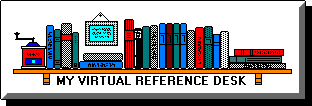
Library Home Page
| |
||||
|---|---|---|---|---|

To go to the
Tech Home Page
Beginning your research:
Let's assume that you have found a topic already for your Long Report -- for instance, "Finding the Best Treatment for Ebola." (Ebola is a deadly disease which has had outbreaks in Africa and also in Texas and Virginia.) You would need to find several separate treatments and then compare them under a set of Criteria set up for evaluating treatments.
The next step is to find source material, by using the books and journals in the library, over the Internet, and by conducting Interviews (all of these 3 types of sources are to be used in your Long Report.)
Electronic Sources in the Louisiana Tech University Library
Prescott Memorial Library has an extensive collection of E-Resources, accessible on the menu below. Use the "back" button on your browser to return to this page. To
go to the
Library Home Page |
|
 To go to the Tech Home Page |
|||||||||||||||||||
Searching the World
Wide Web for Information
Here is a newly
created Technical Communication
Libraray:
Here is another
source which gives advice about
on-line
research and writing:
|
Finding Information on the Internet: A Tutorial |
  |
  |
Other Internet Sources for Research in Language, Literature, and Composition
Online Resources Provided by Writing Centers
A List of On-line Writing Centers
Search Engines
To go to a list of Web Search Engines and information about Search Engines
Specific Search Engines:
The following five search
engines
do a good job in searching through a broad range of text to find needed
key words and concepts. Since they do not cover the same exact source
material,
you should use several of them when doing research on a particular
subject.
Google is very fast.
UncleSam
Google has a specialized variation, which searches only government documents.
Alta Vista
Indexes the text of Internet materials. If you get too many entries, go to theAdvanced Search option.


HotBot
Also does a thorough job of covering sites.

| December
29,
1995
Source A
First Vaccine Against Ebola Virus NEW YORK (Reuters) -- Researchers have developed the first vaccine that effectively immunizes laboratory animals against the deadly Ebola virus. According to a report in the January issue of the journal Nature Medicine, the new vaccine is a form of gene therapy using pieces of DNA that give rise to viral proteins. Injected into the muscles of guinea pigs, the vaccine resulted in proteins that triggered immunity against the virus. In tests, animals exposed to the virus two months after immunization did not become infected. Guinea pigs were used because they are very susceptible to the Ebola virus, just as humans are. According to the study's leader, Dr. Gary Nabel, professor of internal medicine and biological chemistry at the Howard Hughes Medical Institute at the University of Michigan in Ann Arbor, the findings can be viewed as "an important first step" towards a vaccine for the Ebola virus. "Most people who die from Ebola infection have no evidence that they have generated immunity to the virus," Nabel points out. "That's why the news that it is possible to generate immunity to Ebola is good news because we didn't really know that a vaccine would be possible," he says. The vaccine used in the study contains plasmids, segments of laboratory-grown DNA responsible for the production of certain Ebola virus proteins. It is these proteins that the immune system recognizes as foreign. Thus, vaccinated animals exposed to the Ebola virus are able to resist the infection. Ebola virus infection progresses rapidly, causing internal and external bleeding, and is swiftly fatal, often within days. But study co-authors at the Centers for Disease Control and Prevention in Atlanta, Georgia, found no traces of the virus in the organs of any of the immunized animals they examined. Nabel says the next step is to study the vaccine in non-human primates, followed by carefully controlled trials of the vaccine's safety and efficacy in people. "In none of these trials will human subjects be exposed to the Ebola virus," Nabel says. If the next phase of studies proves promising, he estimates that testing in people could begin within one to two years. SOURCE: Nature Medicine (1997;4(1):37-42) |
Recording your research:
The first thing you do is to make a Bibliography
Card for
the
above source, giving the material one would use to find it in the
Library
and to list the article in the Bibliography for your Long Report.
|
SOURCE: Nature Medicine (1997;4(1):37-42) |
You would call this source Source A;
then all the notes you took
from
this article would be put on Information Note Cards, also marked Source
A; at the bottom you would give the exact page number of that
source.
The information on this Information Note Card is the information I have
highlighted in Red in the copy of the Web Page article, above.
The
Page Number of the quotation is given as Page 1. So, an
Information
Note Cards from the above source would look like this:
|
"Ebola virus infection progresses
rapidly, causing
internal and external bleeding, and is swiftly fatal, often within
days.
But study co-authors at the Centers for Disease Control and Prevention
in Atlanta, Georgia, found no traces of the virus in the organs of any
of the immunized animals they examined." page 38
|
Then, when you use the material on the
Note Card and Photocopy in
your
Long Report, you would list it in the Numbered Bibliography. Here
is an example of a numbered Bibliography, done as you are to do it in
this
course. Note that
Source A,
above, becomes Source 5 in the Bibliography below. The note,
above,
from Source A, would then be from Source 5 in your paper. And the
note, since it was taken from page 38 of source 5, would be documented
this
way in your paper: (5:38). In other words, Source 5 in your
bibliography and page 38 in Source 5.
|
|
Using researched material in your Long Report:
Let's assume that the material on the
Information Note Card, above,
has become Source 5 in your numbered Bibliography. Then, you
would
use its number in the Bibliography and the page number on the Note Card
to Document the text of your paper. Here is how the article
material,
put on the note card above, would appear in your Long Report; I have
highlighted
the quoted materia in red:
|
Problem Ebola is a much studied disease;
however, no
one is sure which animal or insect carries it, as the following
quotation
notes: "Ebola virus infection progresses
rapidly,
causing internal and external bleeding, and is swiftly fatal, often
within
days. But study co-authors at the Centers for Disease Control and
Prevention
in Atlanta, Georgia, found no traces of the virus in the organs of any
of the immunized animals they examined" (5:
38). |
 |
As can be seen, frequent documentation of the text is required.
Any fact that is not common knowledge should be documented; anything you did not know before you began your research must have come from your reading; that information should be documented.
Anything that is an opinion, judgment, or interpretation of material must be documented; to show who holds that opinion, etc., since there is not universal agreement about it.
And, it is particularly important that in doing your research you differentiate between facts and opinions and not mistake one for the other yourself and not present one as the other in your paper.
And, you must keep a record of your research by putting everything on note cards, photocopies, or print-outs of material; then, you must keep this material cataloged, as discussed above.
The Note Cards, Bibliography Cards, and
Photocopies
or Print-outs of these sources must also be turned in
with
the paper. Your Long Report package is to be a
product
of your research and is also to be a record
of your
research.
So, your photocopies, print-outs, bibliography cards, and note cards
are
required parts of the Long Report and are to be submitted as part of
the
Long Report package. The grade on the Long Report will be
affected
by the quality of that research package and how well that researched
material
is used to document the Long Report.
The amount of documentation varies with the topic and depth of study; there is no standard number of citations per page for a research paper (a Citation is when you use a source one time; in the above example of a paper, a citation is shown by the numbers in parenthesis. (3:14) is one citation of a source. And, one source will probably be cited several times in the Long Report). The Long Report for English 303 by Internet begins with the assumption (on the Proposal) that a mimimum of 10 sources will be used or cited in the paper. Citations will be used to document that a problem exists, in setting realistic criteria, in describing possible solutions, and in the comparison material used in finding a solution.
With three criteria and three possible solutions, a minimum of 9 citations would have to be used just in the comparison sections. Adding in the Problem section (which must be documented), the Criteria section (which will ordinarily have citations), the minimum of three Graphics (which must be documented), and the Possible Solution section (which must be documented), it would seem that a 10 source paper will have at least 20 citations and most likely a lot more. And, that is not to say that a 10 source paper needs only 20 citations; as stated above, any information brought into the paper from outside sources needs to be cited, if it requires 50 citations to give the sources of the information. And, many papers will have more than the minimum of 10 sources, requiring more citation for the information to be adequately documented.
See also the following English 303 Internet sections for discussion of the above topics:
Information about Documentation and Plagiarism (It is crucial that you know the definition of Plagiarism and the ethical use of source material)
How to Take Notes: Examples of Note Cards and Source Cards (Repeats some of the above material on note taking.)
Summarizing, Quoting, and Citing Print and Electronic Sources (Includes APA and MLA styles and discipline-specific documentation in the fields of Anthropology, Business Writing, Government Publications, History, Legal Writing, and Medicine.)